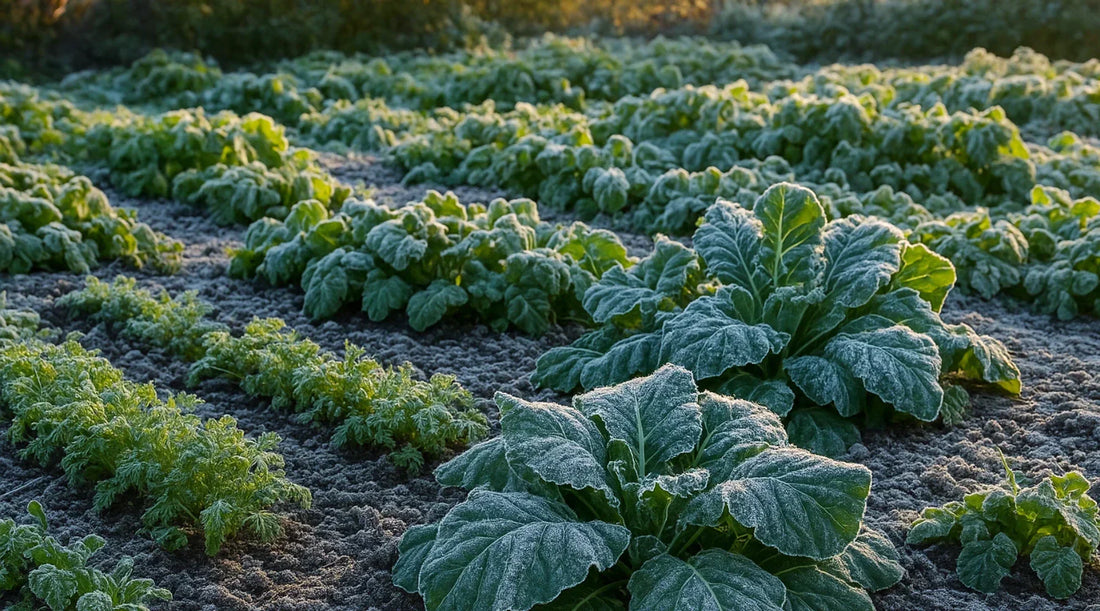
How to Protect Plants From Frost
Wondering how to protect plants from frost? For many gardeners, frost is one of the biggest threats to a thriving garden. A sudden cold snap can leave you waking up to wilted leaves, blackened stems, and plants that look beyond saving.
The good news is, you don’t have to lose your hard work to chilly nights. In this guide, you’ll learn quick and effective ways to shield your plants from frost damage—so your garden stays healthy, resilient, and full of life.
Understanding Frost and Its Impact
Frost happens when temperatures drop low enough for moisture in the air to freeze on surfaces like soil, leaves, and flowers. It usually forms overnight when clear skies and calm winds let heat escape the ground, exposing plants to freezing air.
Not all frosts are the same. A light frost occurs when temperatures dip just below freezing (32°F / 0°C), often causing minor damage to tender plants. A hard frost happens when temperatures fall below freezing for a long time, which can severely damage or kill many plants.
So why does frost cause so much harm? When ice crystals form on plant tissues, they damage the cells inside. This leads to wilted leaves, stunted growth, and in severe cases, plant death. Knowing how frost affects plants is the first step to protecting them before the damage is done.

When to Expect Frost
Frost doesn’t just sneak in during the dead of winter—it can surprise you in early fall or late spring, depending on where you live.
Signs that frost is coming:
- Clear skies at night (heat escapes faster from the ground).
- Calm or still winds (no air movement to keep temperatures balanced).
- Rapid temperature drops after sunset.
- Dew or moisture forming on grass that may freeze overnight.
Regional variations in the USA:
The timing of frost depends heavily on location. Northern states often see their first frost as early as September, while southern regions may not experience it until November or later. Similarly, last frost dates in spring vary—northern areas may have to wait until May, while warmer states are safe to plant by March.
How to check frost forecasts:
The best way to prepare is to track your local frost dates and monitor the weather closely. Use tools like the USDA Plant Hardiness Zone Map or online frost calculators that provide average first and last frost dates by ZIP code. Local weather apps and agricultural extensions are also reliable for real-time frost warnings.
Being alert to these cues means you can cover, move, or protect your plants in time, saving them from overnight damage.
Proven Ways to Protect Plants from Frost
Frost can strike fast, but with the right methods, you can shield your plants from damage. Here are tried-and-true techniques every gardener should know:
1. Cover Your Plants
One of the easiest and most reliable ways to protect plants from frost is to cover them before nightfall. A simple barrier traps heat radiating from the soil and shields delicate leaves from freezing air. You don’t need fancy tools—frost blankets, old bed sheets, burlap or jute fabric, or even lightweight tarps can all do the job.
The key is making sure your cover is secure and doesn’t rest directly on the plants, since frozen fabric can damage foliage.
Do’s:
- ✅ Use breathable materials like frost cloths, burlap, or cotton sheets.
- ✅ Place covers before sunset to trap daytime warmth.
- ✅ Anchor edges to the ground with rocks, bricks, or stakes.
- ✅ Use hoops, stakes, or frames to prevent fabric from touching leaves.
- ✅ Remove covers in the morning once temperatures rise.
Don’ts:
- ❌ Don’t use plastic directly on plants—it can trap condensation and freeze leaves.
- ❌ Don’t forget to secure the edges—loose covers let cold air seep in.
- ❌ Don’t leave covers on during sunny days, as plants may overheat.
2. Mulching for Warmth
A thick layer of mulch insulates the soil and protects plant roots from freezing.
- Use organic mulch like straw, shredded leaves, wood chips, or pine needles.
- Spread 2–4 inches around the base of plants, keeping mulch slightly away from the stems.
- Mulch works best for perennials and root crops that need steady soil warmth.
3. Watering Before Frost
Moist soil absorbs heat during the day and releases it at night, keeping plants warmer than dry soil.
- Water your garden a day before frost is expected.
- Avoid overwatering—just ensure soil is evenly moist.
- Pair this with plant covers for double protection.
4. Using Cloches and Cold Frames
Cloches and cold frames are like mini greenhouses that provide plants with a protective barrier against frost while still letting in light.
Cloches:
- A cloche is a small, portable cover placed over individual plants. Traditionally made of glass, modern cloches can be plastic domes, recycled bottles, or even jars.
- To make your own, cut the bottom off a large clear plastic bottle or milk jug and place it over the plant. Remember to remove the cap for ventilation during the day.
- Cloches are perfect for seedlings, tender vegetables, or small flowering plants.
Cold Frames:
- A cold frame is essentially a low, box-like structure with a clear lid (often made of glass or plastic) that lets in sunlight while keeping out frost.
- You can build one from old windows, wooden planks, or even bales of straw with a sheet of glass laid on top.
Open cloches and cold frames during sunny days to prevent overheating, and close them again in the evening to trap warmth overnight.

5. Bring Containers and Grow Bags Indoors
Move containers somewhere cool enough to protect them from freezing air, but not so warm that it shocks the plants.
Do’s:
- ✅ Place containers, pots or grow bags in a cool, sheltered spot (garage, shed, enclosed porch, or basement).
- ✅ Group pots tightly together to conserve warmth.
- ✅ Cover with lightweight materials like sheets, frost blankets, or burlap for added insulation.
- ✅ Water lightly before bringing them indoors to help soil hold heat.
Don’ts:
- ❌ Don’t place plants right next to a heater or vent—sudden warmth can stress them.
- ❌ Don’t forget to uncover them during the day if outdoors, to let in sunlight.
- ❌ Don’t leave pots sitting on cold concrete—elevate them with wood or trays to prevent root shock.
Long-Term Frost Protection Strategies
1. Build a Greenhouse or Hoop House
Greenhouses and hoop houses provide consistent protection by trapping heat and creating a warmer microclimate for your plants.
- Greenhouses are ideal for year-round gardening and for growing frost-sensitive crops.
- Hoop houses (or high tunnels) are a more affordable option that can cover large garden beds, giving plants shelter from frost while still allowing airflow and sunlight.

2. Plan Your Garden Layout Wisely
Where you plant matters. Position your garden to take advantage of natural warmth and protection.
- Plant frost-sensitive crops on the south-facing side of your yard to capture more sunlight.
- Use fences, hedges, or walls as windbreaks to reduce cold drafts.
- Avoid low-lying areas in your yard, since cold air tends to settle there and increases frost risk.
3. Plant Frost-Tolerant Varieties
| Plant | Cold Tolerance | Harvest Time |
|---|---|---|
| Spinach | Down to 20°F (-6°C) | 35–45 days (baby leaves sooner) |
| Onions | Down to 20°F (-6°C) | 90–120 days (bulbing varieties) |
| Garlic | Hardy below 20°F (-6°C) | Harvest in summer (planted in fall) |
| Leeks | Down to 15°F (-9°C) | 120–150 days |
| Rhubarb | Survives freezing temps | Harvest in spring (established plants) |
| Rutabaga | Down to 20°F (-6°C) | 90–120 days |
| Broccoli | 26–28°F (-3 to -2°C) | 60–100 days |
| Kohlrabi | Down to 25°F (-4°C) | 55–70 days |
| Kale | Down to 20°F (-6°C) | 50–70 days (improves with frost) |
| Cabbage | Down to 20–25°F (-6 to -4°C) | 70–120 days |
| Collards | Down to 20°F (-6°C) | 60–85 days |
| Brussels Sprouts | Down to 20°F (-6°C) | 90–120 days |
| Corn Salad (Mâche) | Hardy to 5°F (-15°C) | 40–60 days |
| Arugula | 25–28°F (-4 to -2°C) | 30–50 days |
| Fava Beans | Down to 20°F (-6°C) | 80–90 days |
| Radish | 25–28°F (-4 to -2°C) | 25–35 days |
| Mustard Greens | Down to 25°F (-4°C) | 30–50 days |
| Austrian Winter Pea | Down to 10°F (-12°C) | 50–60 days (as cover crop/greens) |
| Turnip | Down to 25°F (-4°C) | 30–60 days |
Conclusion
Frost doesn’t have to mean the end of your gardening season. By covering your plants, choosing frost-tolerant varieties, and planning long-term protection strategies like hoop houses or wind barriers, you can safeguard your garden and extend your harvest well into the colder months.
With the right care, your garden doesn’t have to stop when the frost arrives. Protect your plants today and keep them thriving all season long!


